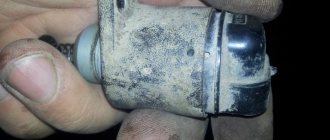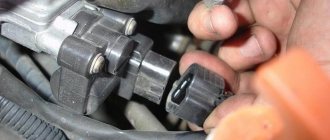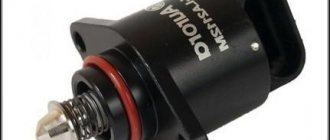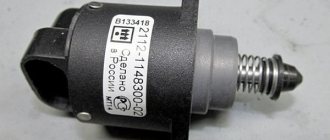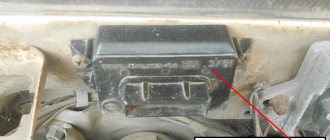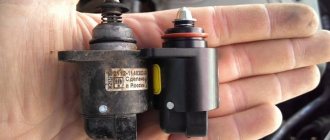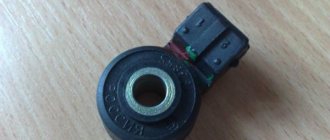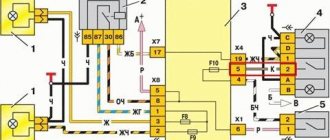Idle speed regulator for VAZ 21099
The car of the domestic automobile industry, the VAZ 21099 injector, became quite popular even with the release of the first models from the assembly line.
Its main advantages over its brother, the 6th model in terms of popularity, was the use of front-wheel drive and injection power units. The use of such engines has significantly improved the quality of operation of the unit itself and the power has increased accordingly. This is due to more efficient combustion and preparation of the fuel mixture through the use of injection injection systems. And with an increase in efficiency, the quality of the exhaust gases increased. But, even though the engine has an order of magnitude more sensors than a six-wheel engine, problems with its operation still appear from time to time. They may be related to the following factors:
- poor quality fuel;
- a defect in the unit itself, in the engine or in the injector;
- defects caused by ambient temperature and humidity;
- incorrect adjustment of the fuel injection device.
One of the most typical and frequent malfunctions is instability of the engine, from small fluctuations within 100 revolutions to large jumps, even stopping the engine. This malfunction most often begins to appear at sub-zero temperatures, and especially when moving from plus to minus and at high relative humidity.
In this case, condensation forms in all air ducts and cavities, and when the temperature drops, it turns into ice because it does not have time to dry completely. Which in turn leads to sticking of the rod, both the throttle valve itself and the cone-shaped valve of the idle air control. It is also called the XX sensor.
The simplest diagnosis of DXX
The easiest way to check the idle speed sensor of the VAZ-2109 is the following method. Need a friend's help. The sensor is disconnected from the connector, then the mounting screws are unscrewed and the device is dismantled. Next, the regulator will be plugged into the connector again, but held in your hands.
At this time, the assistant starts the power unit, and the IAC rod should at this moment retract completely and then extend to a certain distance. If the device behaves this way, then it is operational - the rod is not bent, it is not jammed inside the valve. But there is no guarantee that the device matches the ECU firmware. The rod extends, but the number of steps is unknown. There is a marking on the connector - you can use it to ensure that the ECU sensor matches.
This is the initial stage of diagnosis. Next, check the electrical part, the condition of the valve, and the degree of needle wear.
Characteristics of the XX controller
This part is designed to reduce the engine warm-up time. During this operation, rubbing parts often wear out quickly. So: DXX is also designed to reduce contact and wear. This device is mounted in the throttle assembly, which is located in the engine compartment on the left side of the engine.
Purpose and principle of operation
Main components of the device:
- stepper electric motor;
- conical needle combined with a rod;
- springy part.
As shown in the photo, the device has blocks. The main mechanism is highlighted in red - the idle speed sensor VAZ 21099 injector. The adjusting part that controls the engine speed is visible in gray. Blue – a device designed to read information about the crankshaft rotation speed. If the operation is idling, the air flow enters the main cylinders through special channels.
The green color in this diagram is responsible for comparison in the electronic unit. Here the engine speed is taken into account in accordance with the actual speed.
XX regulation principle
The XX sensor should be called a regulator because it doesn't control anything. But everyone is accustomed to simply calling the entire control circuit assembly a regulator.
Structural scheme
Structurally, the controller circuit can be divided into several functional blocks that perform specific operations:
- controlled;
- manager;
- controlling.
The controlled unit turns on the sensor-motor itself, it opens and closes the air channel.
Sequence of operation of all blocks
The control block is the control circuit. A microcontroller is installed in it, which issues control pulses to the sensor, while controlling the rotation speed. This is carried out by the crankshaft sensor VAZ 21099 injector. Then the controller processes the data received from it and, if necessary, issues the next sequence of pulses.
At the initial moment, when the engine is still cold and not started, the shut-off rod of the XX sensor completely blocks the air duct. And the controller does not produce any pulses. When you turn the key and start the engine, the control unit reads the speed readings from the crankshaft sensor. Since it turns out that there is already rotation, but the valve is not yet open, the controller issues the first impulses to open the air duct. At the same time, it also controls the amount of air consumed using a corresponding sensor.
Then the data from the crankshaft sensor is again read by the controller and it turns out that the speed is lower than required. Then the controller issues the next pulse to the XX sensor, which, having turned another angle, opens the channel more, thereby enriching the mixture better. Consequently, this leads to an increase in the crankshaft speed. When the auxiliary mechanisms reach the set frequency, the controller stops sending pulses to the engine.
With a floating engine speed of a VAZ 21099 car, the injector idle speed sensor most likely has failed, but there may also be a malfunction in the control unit.
Since the diagnostic system of the machine itself is not able to determine the malfunction of the XX sensor, complex measures have to be used. Replace the sensor if replacing the control unit does not help. If the engine roars at full power, but there are no revolutions on the tachometer, then the crankshaft rotation sensor will already be faulty.
Sensor location and design
The idle air control is located in the mounting hole on the throttle body. It is a small cylinder that has two small ears, with the help of which the sensor is directly attached with a cone-shaped needle at the end.
Due to the fact that the sensor is small in size and has a very simplified design, the likelihood of various malfunctions and problems appearing is quite high, and therefore it is important to pay attention to the appearance of the first signs of a malfunction. If problems are observed, it is not recommended to use the vehicle, as the performance of internal structures will deteriorate.
Location of IAC VAZ 2115
How to properly install a new device
We have already discussed how to remove the device, let’s talk about its installation.
Before installing a new device, you need to inspect and clean the air duct and the DXH mounting location.
Installation is carried out in the reverse order from its removal. The rubber sealing ring is lightly lubricated with engine oil before installation. The device itself must be calibrated before installation. The distance from its body to the tip of the conical needle should be 23 mm.
To correct it, the “+” from the battery is applied to the “D” terminal, and the “minus” of the on-board power is applied to the “C” terminal with short touches. So, in small steps, the needle moves to its extreme position and the installation size is again controlled. When the desired needle extension parameter is obtained, the DXX is installed in its place.
As you can see, the process of checking, adjusting and replacing the device is accessible and does not cause any particular difficulties, so you can do this work yourself.
Causes of failure. Node check
The reasons for the malfunction of the XX regulator are breaks in the electrical winding. engine and needle jamming due to dirt or corrosion. But the sensor is not always the “culprit” for missing idle speed. Therefore, before removing and checking the sensor, check its power supply circuit.
For all checks you will need a multimeter. The power circuit is checked with a device set to “voltmeter” mode. Diagnostics is simple - we disconnect the block with wires from the regulator, connect the “negative” probe of the multimeter to ground, and the positive one to the terminals marked with the letters “A” and “D”. With the ignition on, we take measurements. If the circuit is working properly, the readings should correspond to the rated voltage of the circuit. If there is no voltage, you should check the computer and relays responsible for powering the sensor.
Operating principle
When the car is moving and the throttle valve is open, the IAC is not involved in the process, its valve is closed and the rod is motionless. When the damper closes and the engine goes into idle mode, voltage is applied to the electric motor and the rod moves towards the opening - the valve comes into operation. It opens slightly, and air enters the engine bypassing through a special hole.
When the driver turns on the ignition, the IAC rod fully extends to its extreme position and closes the calibration hole in the throttle pipe. The sensor then counts the steps and the valve returns to its home position. As for this basic position, it can be different and depends on the firmware installed in the ECU. For January 5.1 firmware the position is 120 steps, for Bosch firmware it is 50 steps.
Visual inspection and cleaning of the idle air regulator and valve
Step 1: Valve Access . For information about the position of the IAC valve on your vehicle, refer to your vehicle's service manual.
Step 2: Disconnect the valve . Locate the valve's electrical connection and disconnect the idle air valve.
Step 3: Remove the valve from the car . Use the procedure described in your vehicle's service manual to remove the valve.
Step 4: Check the idle air valve . Inspect the valve and mounting location for carbon deposits, rust, or dirt. Check the valve pin and mounting location for damage.
Step 5: Clean the valve and bypass . Use carbon cleaner or intake cleaner solvent to remove debris and dirt from the valve. Use the straw provided with the aerosol can to clean the valve area and bypass.
Warning . Do not use metal wire brushes to clean the valve or bypass circuit. Cleaning the walls or pegs with a wire brush may change the function of the valve.
Replacement or cleaning
Practice shows that in a fairly large number of cases, simply cleaning the idle air regulator allows you to restore its functionality. Therefore, we advise you to try this method first. And if it does not give results, then it will not be difficult to replace the device.
- Buy a container of carburetor cleaner. In this case, your engine may well be fuel-injected. It’s just that this composition is excellent for cleaning IACs and more.
- Disconnect the connector with wires from the sensor, unscrew the two fasteners and remove the affected regulator itself.
- Clean the regulator from accumulated debris and contaminants, and be sure to clean the needle and spring itself. This should be done with carburetor cleaner. Use available tools to tidy up a fairly compact device.
- Be sure to clean the idle air control housing on the throttle assembly. This is where the cone-shaped needle of the XX sensor enters.
- After completing the cleaning of the device, return it to its place and check its operation.
- If cleaning does not bring the desired result, the engine continues to behave inadequately, you will have to purchase a new regulator and install it in place of the old sensor.
- Before replacing, be sure to turn off the power to the car by disconnecting the negative terminal from the battery, then disconnect the block with the power wires, unscrew the mounting screws and remove the device.
- Reassemble in reverse order.
Disassembling the unit for cleaning or replacement
The main thing here is to act carefully and not to overdo it with the carburetor cleaner if you first decide to try cleaning the device. Otherwise, replacing the IAC does not cause problems even for beginners.
How to check the idle speed sensor on a VAZ 2115?
Some difficulties in servicing the IAC on the VAZ 2115 are that the error codes of this unit are not displayed on the on-board computer display. Unlike, for example, TPS, the data of which is reflected on the on-board vehicle. Therefore, the car owner can only check the serviceability of the idle speed sensor manually. To do this, of course, you need to remember where this sensor is located. You can carry out the test armed with a multimeter and asking an assistant to participate.
First you need to open the hood and disconnect the block that provides power from the sensor. In addition, you will need to move the throttle mount some distance from the IAC.
You should not ignore the condition of the regulator circuit; it is best to check it first. Or the problem may be a faulty or discharged battery. In any case, the multimeter will show exactly where the problems occurred. The verification itself can be carried out using the following steps:
- Set the multimeter to voltmeter mode.
- Connect the black probe (minus) to ground, and the red probe (plus) to the outer side terminals of the block (A and D).
- Now the assistant needs to turn on the ignition, and the inspector needs to look at the voltmeter. The device must show at least 12 volts. If the reading is lower, then the battery or alternator needs checking. If there is no reading at all on the multimeter, this is a signal of a faulty wiring or engine control unit. These are the elements that need to be diagnosed.
If everything is normal in the circuit, you should proceed directly to checking the IAC. You will also need a multimeter, but in ohmmeter mode. Diagnostics is as follows:
- The multimeter leads are connected to the terminals on the left side of the valve (A and B) and then to the terminals on the right side (C and D). Normally, the reading on the multimeter should be approximately 53 ohms.
- The probes are connected to terminals A and C, and then to terminals B and D. An infinity symbol should appear on the device.
Other readings on the multimeter indicate a valve failure. There are two options: either replace the faulty part with a new one, or clean it with carburetor cleaner.
WHAT SIGNS INDICATE A MALFUNCTION OF DXH
Any driver, experienced or novice, should be wary of the unusual behavior of the engine during operation. These may be the following phenomena:
- Unstable operation or complete stop of the motor. Failure to operate when the gas pedal is released;
- When the engine is fully warmed up, the idle speed spontaneously increases and decreases;
- After switching off the gear, the engine stops completely;
- When starting a cold engine, there is no increase in the crankshaft speed;
- When other powerful consumers of electricity are connected, the engine speed drops.
Article on the topic: Removing the VAZ 2110 torpedo and installing the trim: detailed instructions with photos
If any of them, or even several signs appear at the same time, you need to pay attention to the performance of the DXH.
HOW TO CHECK THE OPERATION OF DXX
This sensor is not equipped with self-diagnosis elements, like some others, so there will be no signal on the display about its malfunction. On the one hand, this makes it easier to find a faulty unit, but on the other hand, a measuring device is needed to check its functionality. A Chinese digital multimeter is well suited, its cost is low, and it is affordable for any car owner. If you have such a device, then you can start checking its performance.
Checking the idle speed sensor on an injection-type VAZ 2109 is performed as follows:
- The device is placed in position to measure voltage, and the vehicle's on-board network is checked. The device probes installed on the battery terminals should show a voltage slightly more than 12 Volts;
- With the ignition off, disconnect the connector with the wires from the DXX. To do this, you need to press the latch on the plastic housing of the connector with your fingers.
This is clearly visible in the photo on the left. The sensor should only be disconnected or connected when the ignition is turned off to avoid failure of the control unit electronics. The probe of the measuring device is connected to the ground of the machine. Turn on the ignition and use a second probe to check the presence of voltage in the terminals on the connector, which are marked in the photo with the letters A and D. This is clearly visible in the right photo. It must be at least 12 Volts. If it is significantly lower, or is absent altogether, then the culprit may be a break in the supply wires or a failure of the electronics in the motor control unit.
The photo clearly shows where the idle speed sensor is located.
Location of DXX
To remove it, you need to use a Phillips screwdriver and unscrew the two screws securing it.
Removing DXX
- The photo clearly shows the place where the IAC is located. The screw that is closer to the pipe has a “bad habit” of getting lost. To prevent this from happening, first unscrew the left screw. Lightly pull the DXX towards you and unscrew the screw on the right side. In this case, it will remain in the housing hole and will not fall out;
- The measuring device is placed in the position for measuring resistance. The probes are brought to terminals A and B, and then to C and D. The device should show approximately 52 Ohms. This is a working parameter. If you measure the resistance between terminals A and C, and then B and D, the reading should be around infinity. If this is not the case, then the DXX needs to be replaced.
Article on the topic: The design of the stove on the VAZ 2109
You can also check the DXX “by touch”. They do it this way. With the DX removed, but with the wires connected, you need to lightly press down the protruding part of the cone needle with your finger. When you turn on the ignition, it should push your finger. If there is no shock, the sensor is faulty. There is no longer any doubt that the DX is faulty, so we proceed to replace it.
Before replacing the idle speed sensor on the injection VAZ 21099, a few words about choosing a new IAC. Mechanics who work on such systems speak well of the devices produced by . DXX with the KZTA brand also showed good results. When purchasing the latter, you need to take into account the final mark of the regulator. You need to purchase a sensor with the same mark as on the broken device. The cost of the sensor can range from 500 to 700 rubles. There is a new sensor, you can install it.
How to repair idle speed on a VAZ 2109 carburetor engine
On cars of the VAZ 2109 family, Solex-type carburetors are used, which have an electromagnetic valve (EMV) with an idle jet in the idle speed system. The valve is controlled by the electronic forced idle unit.
There are three most common causes of idle speed disappearance:
- clogging of the EMC idle jet;
- EMC burnout;
- lack of power supply to the EMC.
For work you need: wrenches “8”, “10”, “12”, “13”, “14”, a 12 V probe or test lamp with wires, a piece of wire with stripped ends, a compressor or air pump.
Remove the air filter housing cover by unscrewing the nut with a “10” wrench and unfastening the spring clips. Remove the air filter.
We unscrew the four nuts with a key “8”, use a screwdriver to loosen the clamp of the crankcase ventilation hose at the point of connection to the valve cover and remove the air filter housing.
Turn on the ignition. Remove the power wire from the solenoid valve.
We try to touch the power wire terminal to the EMC terminal several times. At the moment of contact, distinct clicks should be heard. If this is not the case, then unscrew the EMC from the carburetor cover. Using an additional piece of wire, we apply the “+” from the battery to the terminal of the EMC, and with its body we touch the “–” terminal of the battery several times. At the moment of contact, distinct clicks should be heard.
If there are no clicks, the valve is burnt out. We replace it with a serviceable one, after checking it first.
To get to the nearest auto shop, you can convert a faulty EMC into a forced open one. To do this, remove the idle fuel jet with two fingers, break off the plastic tip of the valve, and put the jet and EMC in place.
We put the wires in place and start the engine. When using such a valve, problems may arise with turning off the engine: it will try to work after the ignition is turned off. In such a situation, you don’t need to turn it off right away, but let it run for 1-2 minutes, and after turning off the ignition, smoothly press the gas pedal all the way.
If the EMC is working normally, you need to check the idle jet. To do this, unscrew the valve from the carburetor cover. Using two fingers, remove the idle fuel jet. Pay attention to the central hole: remove debris from it using a compressor or air pump.
We install the jet and EMC in place and tighten it until it stops.
If the solenoid valve is working properly, the jet is not clogged, and there is still no idle speed, then the electronic forced idle speed control unit may have failed.
What you need to know when buying a used car
Since 1998, the VAZ 21099 began to be equipped with injection engines, which are a priority to buy. Once you own a used car, you will often need to repair it yourself. There is nothing wrong with this; changing the knock sensor of a VAZ 21099, whose injector has begun to act up, will not be difficult. Most operations do not require special training or special knowledge - you can do everything yourself by watching a video from YouTube or reading step-by-step instructions on the Internet.
The best way to check the condition of the engine is to measure the compression in the cylinders. For 21099, the best result will be 13 units, and if it is less than 10, then a major engine overhaul will be required. It is worth considering the fact that the difference in readings when measuring in different cylinders should not exceed 1%. It is not advisable to buy a car with a dirty, oily engine, as this indicates serious damage. Beware of cars with ECU problems, since a failed VAZ 21099 or 21115 throttle sensor can ruin your nerves for a long time, you will get tired of looking for the cause of the breakdown.
Terminals in the engine compartment require additional care
After purchasing a VAZ 21099, it is advisable to treat all electrical contacts on the engine compartment terminals, including the fuse box, with a special agent. Experts advise that when buying a used VAZ, do not change the antifreeze and oil immediately, but take a closer look - maybe the car you bought does not need it.
Advantages of purchasing a VAZ 21099:
- cheap spare parts;
- low cost of the car;
- strong and elastic bumpers that can withstand not very strong impacts;
- low fuel consumption, especially for injection models;
- good thrust at low speeds for this engine size.
21099 also has disadvantages:
- low-quality engine attachments, defective parts;
- strong rattling of the interior, low sound insulation;
- constant problems with the cooling system in summer and with electronics in winter;
- The quality of the sensors leaves much to be desired.
Thus, the VAZ 21099 throttle sensor is afraid of moisture and fails after 5,000 kilometers, in particular the idle speed sensor is a “ninety-ninth” problem.
https://youtube.com/watch?v=yj3rXyRVerI
Considering that this model was produced in the Russian Federation until 2004, and in Ukraine until 2011, it is quite difficult to find a used car without problems. However, if you are not afraid of the prospect of doing small repairs yourself, this budget option will be ideal.
Principle of operation
It is not entirely correct to call the idle speed sensor a sensor. After all, they are measuring instruments that process and convert information, displaying it on mechanical or electronic indicators on the dashboard.
Alas, the self-diagnosis systems on the VAZ 2109 are not perfect, therefore, if the idle air regulator fails, the car does not notify you about it even by turning on the Check Engine warning light. Therefore, you have to navigate by signs of breakdown.
The IAC works as follows. When the ignition switch is turned on, the rod on the sensor extends all the way and rests against a special hole in the throttle pipe. The IAC begins to read the steps and the valve returns to its original position. When the engine is running, increasing or decreasing the number of steps causes a change in the volume of air entering through the hole. Consequently, the required amount of air flows into the engine, ensuring stable operation of the engine at idle.
